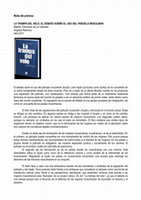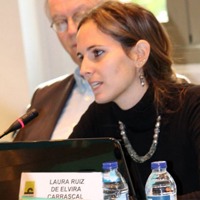Books by ANGELES RAMIREZ

ENGLISH - Why is the veil forbidden in some countries and in others women are forced to wear it? ... more ENGLISH - Why is the veil forbidden in some countries and in others women are forced to wear it? is it compatible to wear a veil and to be a feminist? are we feminists if we defend the right to wear a veil? is there agreement among feminists on the use of the veil? how has feminism positioned itself in relation to the veil and Muslim women from colonial times to the present day?
- The authors Ángeles Ramírez and Laura Mijares, professors at the Universidad Autónoma and the Universidad Complutense de Madrid, answer these questions and analyze the always complex relationship of feminisms with Islam and Muslim women.
This book focuses on the enormous diversity of situations that accompany the use of the veil among Muslim women, which at times may reflect their subordination but at other times constitutes a tool of resistance against patriarchy or even against racism and Islamophobia. It analyzes how feminism has also taken different positions according to the historical moment and social contexts: there is no single position with respect to the headscarf and this diversity causes divisions within the movement.
The Muslim population in Europe has been represented as the bearer of a primitive and violent culture, which oppresses women, reinforcing the colonial stereotype. This idea has become the main argument for imposing policies that restrict the fundamental rights of this population, particularly women, by banning the hijab and the face veil (niqab).
This prohibitionist wave has been sweeping Europe since the 1990s, responding to the agenda of the right and the ultra-right. It is based on the "feminist" idea that the headscarf ban "rescues" Muslim women from men and the inequality imposed on them by their culture. This idea, known as gender Islamophobia, is increasingly widespread and makes the violence of prohibitionist measures directed against women invisible and tolerable.
According to the authors, these policies respond to a racist agenda, which self-interestedly assigns a single meaning to the headscarf, that of oppression, in order to intervene on the bodies of Muslim women. Therefore, the biggest problem of Muslim women in Europe is not men, Islam or the veil, as a sector of feminism - the so-called enlightened - maintains, but racism. Anti-racist feminism has begun to build a reflection and a militancy of diversity, but here too the idea of a single meaning of Islam or of the headscarf continues to keep Muslim women away from this feminist militancy, forcing them to look for other spaces. Also in feminism, we must talk more about racism and less about hijab.
April 8, 2020 (second edition, July 2022)
Este libro, editado por Ángeles Ramírez, es producto de una investigación colectiva cuyo punto de... more Este libro, editado por Ángeles Ramírez, es producto de una investigación colectiva cuyo punto de partida fue el análisis
de la formación, estructura y organización de lo que, en un principio,
se definió como diáspora musulmana en España, con especial incidencia
en la interacción con los dispositivos de poder. Hay dos claves de lectura en el ámbito que trata este libro. En primer lugar, la consideración y el alcance de la conceptualización académica en la reproducción del pensamiento hegemónico. No se cuestiona en este libro que la ideología dominante es la ideología de la clase dominante y que, en este sentido, la universidad es uno de los pilares de la reproducción de este conocimiento. La cuestión es hasta qué punto las categorías que empleamos cotidianamente nos están llevando a reproducir de modo circular la situación de subalternidad y objetivación de lo musulmán.
Obra colectiva de homenaje al antropólogo americano especialista en el Rif David Montgomey Hart d... more Obra colectiva de homenaje al antropólogo americano especialista en el Rif David Montgomey Hart dividida en cuatro partes: Parte I, "Memoria de David M. Hart" con artículos de Vicente Moga, Rémy Leveau, Dale Eickelmen, y Encarna Cabello; Parte II, "Africanismos y orientalismos. El legado antropológico en Marruecos", con artículos de J.Ll. Mateo Dieste, J.L. Villanova, Danielle Provensal, y María Cardeira; Parte III, "Imágenes y representaciones de Marruecos" con artículos de M. Rosa de Madariaga, Eloy Martín Corrales, Joelle Bergere, A. Bouzalmate, Mohamed Benaboud, Michael Suleiman y Laura Feliu; y Parte IV, "Tribus, poder e identidades en el Marruecos rural" con artículos de Mokhtar El Harras, M. Benali, M.A. Roque, A. Lakhsassi y Mohamed Tozy, A. López Bargados, M. A. Parejo, Yolanda Aixelá y R. Leveau.
Estudio multidisciplinar de la inmigración marroquí en España, en todos sus aspectos, realizado p... more Estudio multidisciplinar de la inmigración marroquí en España, en todos sus aspectos, realizado por los mejores especialistas españoles y marroquíes. Especialmente centrado en el estudio de las redes de la inmigración: la relación entre las regiones de origen y las regiones de destino. Acompañado de multitud de mapas, gráficos, tablas, producto de las bases de datos elaboradas por el equipo de investigación del Taller de Estudios Internacionales Mediterráneos de la Universidad Autónoma de Madrid.

April 2011. This book is about the social and legal regulations of the Muslim headscarf (hijab). ... more April 2011. This book is about the social and legal regulations of the Muslim headscarf (hijab). These can be addressed in two ways: forcing women to wear it or restricting its use. The first applied in certain Muslim countries, while the latter are given, with exceptions, in contexts in which Islam is minoritary. Both have a common goal: the domination of women through the normativization of their bodies.
There is a double axis of domination of Muslim women, the patriarchal and the Islamophobia. In the first, the hijab can become a tool to control women's sexuality, while Islamophobia use the hijab as an icon of cultural difference and an excuse to restrict the rights of Muslim minorities as a whole. Through a comprehensive review of policy and regulatory contexts, the book wants to be an instrument of debate. It resituates the debate in a new place far from the approaches that regard the headscarf as a form of cultural resistance and from those which are seeking to snatch women's headscarf to liberate them from their own culture as well.
Las otras migraciones : la emigración de menores marroquíes no acompañados a España
Desarrollo y pervivencia de las redes de origen en la inmigración marroquí en España
Arraigados. Minorías religiosas en la Comunidad de Madrid
Papers by ANGELES RAMIREZ
Segmentaciones feministas en torno al pañuelo musulmán: feminismos, islam e izquierda en Francia
Viento sur: Por una izquierda alternativa, 2016
OSO, Laura: La migración hacia España de mujeres jefas de hogar.Instituto de la Mujer, 1998
Migraciones, 1999
Crítica. Migraciones, género, Islam
OFRIM. Boletín, 1999
Mujeres de Marruecos: panorama social y jurídico
Page 1. ATLAS DE LA INMIGRACIÓN MARROQUÍ EN ESPAÑA 37 Mujeres de Marruecos: panorama social y jur... more Page 1. ATLAS DE LA INMIGRACIÓN MARROQUÍ EN ESPAÑA 37 Mujeres de Marruecos: panorama social y jurídico Ángeles Ramírez La primacía de lo jurídico Si se habla de la situación social y jurídica de las mujeres, se ...
Las mujeres marroquíes en España a lo largo de los noventa
Page 1. esto con la apertura de una nueva región migratoria, la Europa del sur1. Lo cierto es que... more Page 1. esto con la apertura de una nueva región migratoria, la Europa del sur1. Lo cierto es que estos países ofrecen un mercado laboral inmigrante diferente al que había existido hasta entonces, con una gran importancia ...
DOAJ (DOAJ: Directory of Open Access Journals), Mar 1, 2011

Femmes sans frontières: service domestique transfrontalier à Sebta
Hespéris, Tamuda, 2020
Sebta and Melilia, two cities under Spanish sovereignty on Moroccan territory, have since their c... more Sebta and Melilia, two cities under Spanish sovereignty on Moroccan territory, have since their creation been border areas that generate specific social, economic and symbolic relationships with Morocco and within them. Without forgetting their importance as gateways to the Schengen area and its impact on the “reception” of the immigrant population, there are lesser known and yet very important processes for cities and their surroundings. An example of these situations is the daily crossing of the border by the bragdiat or porteadoras, which is a phenomenon that has recently received the attention of researchers and politicians in Morocco and Spain. On the other hand, the issue of cross-border housekeepers is much more invisible. Those women cross borders every day to join their jobs at homes in cities. This article, the preliminary result of an ongoing research, addresses the issue of cross-border domestic service between the city of Sebta and the Moroccan cities near the border, from the point of view of the relationship between neoliberal policies and strategies and resistance from border populations.
El debate sobre los feminismos postcoloniales: asociaciones musulmanas y participación femenina en Marruecos
Los feminismos ante el islam
Migraciones, género e Islam: mujeres marroquíes en España
Universidad Autónoma de Madrid eBooks, 1997
Tesis doctoral inédita. Universidad Autónoma de Madrid, Facultad de Ciencias Económicas y Empresa... more Tesis doctoral inédita. Universidad Autónoma de Madrid, Facultad de Ciencias Económicas y Empresariales, Departamento de Sociología y Antropología Social.Fecha de lectura: 16-4-97Bibliografía: p. 507-53
Control over female ‘Muslim’ bodies: culture, politics and dress code laws in some Muslim and non-Muslim countries
Identities-global Studies in Culture and Power, Oct 9, 2014
Control of the female body is a key component of both the formation of Muslim identities and the ... more Control of the female body is a key component of both the formation of Muslim identities and the control of Muslim communities in European countries. I will argue that the regulation of the clothing worn by Muslim women, both the restriction of its use (which occurs mainly in non-Muslim countries) and the requirement to wear a particular item, share the same goal: the control of women’s bodies. In this respect, I will consider both the legal regulations that require women to wear the so-called ‘Muslim’ clothing and those that restrict it as a way of disciplining the population, and will focus on the control of women as a privileged form of political control.











Uploads
Books by ANGELES RAMIREZ
- The authors Ángeles Ramírez and Laura Mijares, professors at the Universidad Autónoma and the Universidad Complutense de Madrid, answer these questions and analyze the always complex relationship of feminisms with Islam and Muslim women.
This book focuses on the enormous diversity of situations that accompany the use of the veil among Muslim women, which at times may reflect their subordination but at other times constitutes a tool of resistance against patriarchy or even against racism and Islamophobia. It analyzes how feminism has also taken different positions according to the historical moment and social contexts: there is no single position with respect to the headscarf and this diversity causes divisions within the movement.
The Muslim population in Europe has been represented as the bearer of a primitive and violent culture, which oppresses women, reinforcing the colonial stereotype. This idea has become the main argument for imposing policies that restrict the fundamental rights of this population, particularly women, by banning the hijab and the face veil (niqab).
This prohibitionist wave has been sweeping Europe since the 1990s, responding to the agenda of the right and the ultra-right. It is based on the "feminist" idea that the headscarf ban "rescues" Muslim women from men and the inequality imposed on them by their culture. This idea, known as gender Islamophobia, is increasingly widespread and makes the violence of prohibitionist measures directed against women invisible and tolerable.
According to the authors, these policies respond to a racist agenda, which self-interestedly assigns a single meaning to the headscarf, that of oppression, in order to intervene on the bodies of Muslim women. Therefore, the biggest problem of Muslim women in Europe is not men, Islam or the veil, as a sector of feminism - the so-called enlightened - maintains, but racism. Anti-racist feminism has begun to build a reflection and a militancy of diversity, but here too the idea of a single meaning of Islam or of the headscarf continues to keep Muslim women away from this feminist militancy, forcing them to look for other spaces. Also in feminism, we must talk more about racism and less about hijab.
April 8, 2020 (second edition, July 2022)
de la formación, estructura y organización de lo que, en un principio,
se definió como diáspora musulmana en España, con especial incidencia
en la interacción con los dispositivos de poder. Hay dos claves de lectura en el ámbito que trata este libro. En primer lugar, la consideración y el alcance de la conceptualización académica en la reproducción del pensamiento hegemónico. No se cuestiona en este libro que la ideología dominante es la ideología de la clase dominante y que, en este sentido, la universidad es uno de los pilares de la reproducción de este conocimiento. La cuestión es hasta qué punto las categorías que empleamos cotidianamente nos están llevando a reproducir de modo circular la situación de subalternidad y objetivación de lo musulmán.
There is a double axis of domination of Muslim women, the patriarchal and the Islamophobia. In the first, the hijab can become a tool to control women's sexuality, while Islamophobia use the hijab as an icon of cultural difference and an excuse to restrict the rights of Muslim minorities as a whole. Through a comprehensive review of policy and regulatory contexts, the book wants to be an instrument of debate. It resituates the debate in a new place far from the approaches that regard the headscarf as a form of cultural resistance and from those which are seeking to snatch women's headscarf to liberate them from their own culture as well.
Papers by ANGELES RAMIREZ
- The authors Ángeles Ramírez and Laura Mijares, professors at the Universidad Autónoma and the Universidad Complutense de Madrid, answer these questions and analyze the always complex relationship of feminisms with Islam and Muslim women.
This book focuses on the enormous diversity of situations that accompany the use of the veil among Muslim women, which at times may reflect their subordination but at other times constitutes a tool of resistance against patriarchy or even against racism and Islamophobia. It analyzes how feminism has also taken different positions according to the historical moment and social contexts: there is no single position with respect to the headscarf and this diversity causes divisions within the movement.
The Muslim population in Europe has been represented as the bearer of a primitive and violent culture, which oppresses women, reinforcing the colonial stereotype. This idea has become the main argument for imposing policies that restrict the fundamental rights of this population, particularly women, by banning the hijab and the face veil (niqab).
This prohibitionist wave has been sweeping Europe since the 1990s, responding to the agenda of the right and the ultra-right. It is based on the "feminist" idea that the headscarf ban "rescues" Muslim women from men and the inequality imposed on them by their culture. This idea, known as gender Islamophobia, is increasingly widespread and makes the violence of prohibitionist measures directed against women invisible and tolerable.
According to the authors, these policies respond to a racist agenda, which self-interestedly assigns a single meaning to the headscarf, that of oppression, in order to intervene on the bodies of Muslim women. Therefore, the biggest problem of Muslim women in Europe is not men, Islam or the veil, as a sector of feminism - the so-called enlightened - maintains, but racism. Anti-racist feminism has begun to build a reflection and a militancy of diversity, but here too the idea of a single meaning of Islam or of the headscarf continues to keep Muslim women away from this feminist militancy, forcing them to look for other spaces. Also in feminism, we must talk more about racism and less about hijab.
April 8, 2020 (second edition, July 2022)
de la formación, estructura y organización de lo que, en un principio,
se definió como diáspora musulmana en España, con especial incidencia
en la interacción con los dispositivos de poder. Hay dos claves de lectura en el ámbito que trata este libro. En primer lugar, la consideración y el alcance de la conceptualización académica en la reproducción del pensamiento hegemónico. No se cuestiona en este libro que la ideología dominante es la ideología de la clase dominante y que, en este sentido, la universidad es uno de los pilares de la reproducción de este conocimiento. La cuestión es hasta qué punto las categorías que empleamos cotidianamente nos están llevando a reproducir de modo circular la situación de subalternidad y objetivación de lo musulmán.
There is a double axis of domination of Muslim women, the patriarchal and the Islamophobia. In the first, the hijab can become a tool to control women's sexuality, while Islamophobia use the hijab as an icon of cultural difference and an excuse to restrict the rights of Muslim minorities as a whole. Through a comprehensive review of policy and regulatory contexts, the book wants to be an instrument of debate. It resituates the debate in a new place far from the approaches that regard the headscarf as a form of cultural resistance and from those which are seeking to snatch women's headscarf to liberate them from their own culture as well.